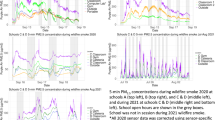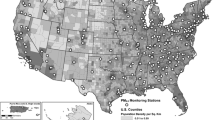Abstract
Health concerns about air quality by community members led to this collaborative study to determine the magnitude and distribution of wood smoke in the Cranbrook–Kimberley area of the East Kootenay region of British Columbia, Canada. The concentration of microscopic particles, 2.5 μm or less in diameter (PM2.5), has a strong association with mortality, hospitalizations and pulmonary symptoms. This was measured by mobile nephelometer, along with GPS readings, temperature, humidity and wind velocity, during 18 consecutive evening drives along a predetermined route in the winter of 2011. Mean temperature and wind velocity ranged from −21 to +6 °C and 0 to 12.6 km/h, respectively. Average nephelometer readings for the 18 evenings ranged from 2 to 9 μg/m3, correlating inversely with mean temperature, but because of varying amounts of wood stove emissions, the relationship was not apparent at any one location during any individual drive. The mean deviation between the mean measured PM2.5 for each evening and that predicted from the average temperature and wind velocity was 1.1 μg/m3. Some 13,000 nephelometer readings (each 15 s average) were plotted within 500 and 250 m square grid cells encompassing the route. The mean and maximum values obtained within the larger cells ranged from 1 to 11 and 6 to 90 μg/m3, respectively. Four specific locations of high average mean and maximum values were identified, with four additional hotspots noted with the smaller cells. This project demonstrates what can be accomplished with cooperation among inspired individuals and citizen groups. The pinpointed hotspots can focus additional surveys of wood stove use and provide baseline data to gauge effects of airshed management strategies, provide information for land use planning and review of bylaws specific to air quality. The project partners hope these results will aid local governments to increase public awareness of health implications of wood burning emissions, implement future monitoring and provide education for the proper use of wood as a heating fuel.





Similar content being viewed by others
References
Abel T, Burkholder B, Nicklason L, Willis P (2006) An air emissions inventory for Golden. The Ministry of Environment Environmental Quality Section, British Columbia
Allen R, Larson T, Sheppard L, Wallace L, Liu S (2003) Use of real-time light scattering data to estimate the contribution of infiltrated and indoor-generated particles to indoor air. Environ Sci Technol 37:3484–3492
Boldo E, Medina S, LeTertre A, Hurley F, Mücke HG, Ballester F, Aguilera I, Eilstein D, APHEIS Group (2006) Apheis: health impact assessment of long-term exposure to PM(2.5) in 23 European cities. Eur J Epidemiol 21:449–458
Canadian Council of Ministers of the Environment (2000) Canada-wide standards for particulate matter and ozone. http://www.ccme.ca/assets/pdf/pmozone_standard_e.pdf. Accessed 06 Sept 2013
CEPA/FPAC: Federal-Provincial Working Group on Air Quality Objectives and Guidelines (1999) Addendum to science assessment document particulate matter ≤10 μm and ≤2.5 μm, December 1997, revised April 1999
Citizens for a Livable Cranbrook. http://livablecranbrook.blogspot.ca/p/clcs-vision-and-mission-statement.html. Accessed 06 Sept 2013
Dal Sasso R (2010) Integrating nephelometer visibility and particulate monitoring. AWMA, Xian, China, May. http://www.dri.edu/images/stories/editors/leapfrog/techprog/IIIa_1_DalSasso.pdf. Accessed 06 Sept 2013
Elliott CT, Copes R (2011) Burden of mortality due to ambient fine particulate air pollution (PM2.5) in interior and Northern BC. Can J Public Health 102:390–393
ESRI ArcGIS. http://resources.arcgis.com/en/help/main/10.1/index.html. Accessed 06 Sept 2013
Evans GJ, Jeong C-H (2007) Data analysis and source apportionment of PM2.5 in Golden, British Columbia using positive matrix factorization (PMF). A final report for research contract for Environment Canada by the Southern Ontario Centre for Atmospheric Aerosol Research, University of Toronto, Ontario, 30 April
Hall D (2009) Mobile nephelometer monitoring for wintertime fine particulate matter in the city of Nanaimo BC. Report by Environmental Protection, Ministry of the Environment, Nanaimo, BC, winter
Health Canada (2007) National ambient air quality objectives for particulate matter—executive summary. http://www.hc-sc.gc.ca/ewh-semt/pubs/air/naaqo-onqaa/particulate_matter_matieres_particulaires/summary-sommaire/index-eng.php#a11. Accessed 06 Sept 2013
Houck JE, Tiegs PE, McCrillis RC, Keithley C, Crouch J (1998) Air emissions from residential heating: the wood heating option put into environmental perspective. Proc U S EPA Air Waste Manag Assoc Conf Emission Invent Living Global Environ 1:373–384
Hystad PU, Setton EM, Allen RW, Keller PC, Brauer M (2009) Modeling residential fine particulate matter infiltration for exposure assessment. J Expo Sci Environ Epidemiol 19:570–579
Jerrett M, Burnett RT, Ma R, Pope CA 3rd, Krewski D, Newbold KB, Thurston G, Shi Y, Finkelstein N, Calle EE, Thun MJ (2005) Spatial analysis of air pollution and mortality in Los Angeles. Epidemiology 16:727–736. (http://www.arb.ca.gov/carbis/research/seminars/Jerrett/Jerrett.pdf)
Kurmi OP, Semple S, Simkhada P, Smith WC, Ayres JG (2010) COPD and chronic bronchitis risk of indoor air pollution from solid fuel: a systematic review and meta-analysis. Thorax 65:221–228
Larson TV, Koenig JQ (1994) Wood smoke: emissions and noncancer respiratory effects. Ann Rev Public Health 15:133–156
Larson T, Su J, Baribeau AM, Buzzelli M, Setton E, Brauer M (2007) A spatial model of urban winter woodsmoke concentrations. Environ Sci Technol 41:2429–2436
Laumbach RJ, Kipen HM (2012) Respiratory health effects of air pollution: update on biomass smoke and traffic pollution. J Allergy Clin Immunol 129:3–11
Lin L, Lee ML, Eatough DJ (2010) Review of recent advances in detection of organic marker in fine particulate matter and their use for source apportionment. J Air Waste Manag Assoc 60:3–25
Mehta S, Shin H, Burnett R, North T, Cohen AJ (2013) Ambient particulate air pollution and acute lower respiratory infections: a systematic review and implications for estimating the global burden of disease. Air Qual Atmos Health 6:69–83
Milward K, Van Winden J (2010) Study summary: monitoring of residential wood burning emissions in the Cowichan Valley Regional District. Report by Engineering & Environmental Services, Cowichan Valley Regional District of BC
Ministry of Environment (2009) Objectives and standards. http://www.bcairquality.ca/regulatory/pm25-objective.html. Accessed 06 Sept 2013
New Horizons for Seniors. http://www.hrsdc.gc.ca/eng/community_partnerships/seniors/index.shtml. Accessed 06 Sept 2013
Nolte CG, Schauer JJ, Cass GR, Simoneit BR (2001) Highly polar organic compounds present in wood smoke and in the ambient atmosphere. Environ Sci Technol 35:1912–1919
Noonan CW, Ward TJ, Navidi W, Sheppard L, Bergauff M, Palmer C, HEI Health Review Committee (2011) Assessing the impact of wood stove replacement program on air quality and children’s health. Res Rep Health Eff Inst 162:3–37
NYSERDA: New York State Energy Research and Development Authority (2010) Spatial modeling and monitoring of residential wood smoke across a non-urban upstate New York region. New York State Energy Research and Development Authority, Albany
Po JY, Fitzgerald JM, Carlsten C (2011) Respiratory disease associated with solid biomass fuel exposure in rural women and children: systematic review and meta-analysis. Thorax 66:232–239
Poplawski K, Setton E, Deschenes S (2010) Mobile nephelometer for ambient PM2.5 monitoring: operational procedures for use with the M903 Radiance Research nephelometer and Garmin GPSMAP 60Cx. Prepared by Spatial Sciences Research Laboratory, Department of Geography, University of Victoria, BC. http://web.uvic.ca/~ssrl01/SSRLtemp/Nephelometer%20Manual%202010.pdf. Accessed 06 Sept 2013
Samet JM, Dominici F, Curriero FC, Coursac I, Zeger SL (2000) Fine particulate air pollution and mortality in 20 U.S. cities, 1987–1994. N Engl J Med 343:1742–1749
Setton E, Lightowlers C, Poplawski K, Hystad P, Keller CP (2007) Monitoring of fine particulate matter associated with back yard burning in the Capital Regional District: a comparison of municipalities with different burning bylaws. Final Report by University of Victoria Spatial Sciences Research Lab for Vancouver Island Health Authority Capital Regional District Environmental Services, BC, 21 March. http://web.uvic.ca/~ssrl01/SSRLtemp/Backyard%20Burning.pdf. Accessed 06 Sept 2013
Shah AS, Langrish JP, Nair H, McAllister DA, Hunter AL, Donaldson K, Newby DE, Mills NL (2013) Global association of air pollution and heart failure: a systematic review and meta-analysis. Lancet. doi:10.1016/S0140-6736(13)60898-3 [Epub ahead of print]
Su JG, Buzzelli M, Brauer M, Gould T, Larson TV (2008) Modeling spatial variability of airborne levoglucosan in Seattle, Washington. Atmos Environ 42:5519–5525
Wagstrom KM, Pandis SN (2011) Contribution of long range transport to local fine particulate matter concerns. Atmos Environ 45:2630–2735
Wakelin T, Rensing M (2004) 2000 British Columbia emissions inventory of criteria air contaminants (electronic resource): methods and calculations. British Columbia Ministry of Water, Land and Air Protection: Water, Air and Climate Change Branch, Victoria, BC, October, revised 2005. http://www.bcairquality.ca/reports/pdfs/2000_inven_rep.pdf. Accessed 06 Sept 2013
Ward T, Palmer C, Bergauff M, Hooper K, Noonan C (2008) Results of a residential indoor PM2.5 sampling program before and after a woodstove changeout. Indoor Air 18:408–415
Wildsight. http://www.wildsight.ca. Accessed 06 Sept 2013
World Health Organization (2006) WHO air quality guidelines for particulate matter, ozone, nitrogen dioxide and sulphur dioxide—global update 2005-summary of risk assessment. http://whqlibdoc.who.int/hq/2006/who_sde_oeh_06.02_eng.pdf. Accessed 30 Aug 2013
Xue H, Wakelin T (2006) Residential wood burning in British Columbia: public behavior and opinion. British Columbia Ministry of Environment, Environmental Protection Division: Water, Air and Climate Branch, Air Protection Section, Victoria, British Columbia, May. http://www.bcairquality.ca/reports/pdfs/woodstove_emissions_0706.pdf. Accessed 06 Sept 2013
Acknowledgments
This “Partners in Winter Air Quality Project 2011” was a truly collaborative project. Funding, equipment and specialized expertise and assistance in various aspects of the study were provided by (a) the Government of Canada’s New Horizons for Seniors program, (b) the East Kootenay Citizens for Clean Air committee, (c) the Ministry of Environment, (d) the Ministry of Forests, Land and Natural Resource Operations, (e) Wildsight, (f) Interior Health, (g) University of Victoria, (h) College of the Rockies, (i) members of the Citizens for a Livable Cranbrook Society and additional community volunteers. Special mention goes to the two prime activists, Erna Jensen-Shill and Sharon Cross.
Author information
Authors and Affiliations
Corresponding author
Additional information
Figures 3, 4 and 5 are available in color in the online version of this article (doi:10.1007/s11869-013-0203-1).
Rights and permissions
About this article
Cite this article
Loeppky, J.A., Cagle, A.S., Sherriff, M. et al. A local initiative for mobile monitoring to measure residential wood smoke concentration and distribution. Air Qual Atmos Health 6, 641–653 (2013). https://doi.org/10.1007/s11869-013-0203-1
Received:
Accepted:
Published:
Issue Date:
DOI: https://doi.org/10.1007/s11869-013-0203-1




